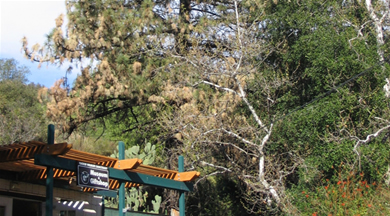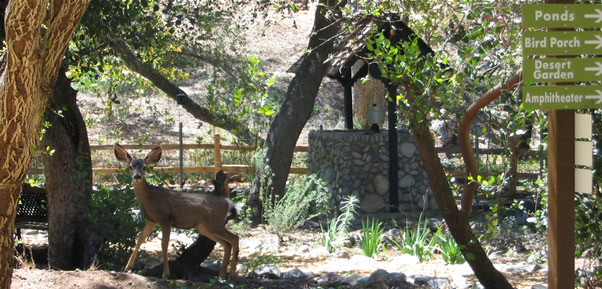How Dry I Am
If They Could Speak, that Would Be Modjeska Canyon Animals’ Refrain
October 1, 2007
By Russ Hudson
Cal State Fullerton’s Tucker Wildlife Sanctuary, located at the end of Modjeska Canyon, welcomed the recent light rainstorm that passed through, but that little bit of moisture didn’t rid the sanctuary of its uninvited guest, a drought that has brought problems.
“We have five mule deer staying on the grounds. Mostly they are mothers with their fawns and yearlings, just trying to survive,” said Marcella Gilchrist, Tucker’s site director and a permanent resident of the sanctuary. “There is no greenery up in the hills right now because of the very dry year and they need that for the young.”
“But the real potential problem is that the deer have attracted mountain lions,” she said. “The deer are one of their main food sources. We’ve had at least five clear mountain lion sightings recently.”

The fire department has been keeping records of the moisture content of the vegetation in Modjeska Canyon for several decades, Gilchrist said, “and they told us it is the driest it’s ever been in this area.
“The drought, exacerbated by the two heat waves in September, has really been hard on the wildlife,” she pointed out, adding that other animals not often sighted in the neighborhood are showing up, looking for something to survive on. “Here in Modjeska Canyon, next to the hills and Cleveland National Forest, we’re considered an urban fringe area. This is where desperate animals show up.”
Still others, though, are becoming scarce. “Seed-eating birds are thinning out because so few plants have flowered this year. The same is true with the rodent population. And, of course, this cascades. If one species is missing then others that need them are thinning, too. Everything is just sort of tamping down, following nature’s pattern in situations like this.”
Those living and working at and around the sanctuary are preparing for the worst while hoping for the best, the site director said. “We’re concerned about fire. Everything is so dry and this rain won’t change that much. We’ve lost two pine trees. We’ve tried to water them, but it’s a situation where they needed to be watered last year for this year. We’re also thinning out the vegetation, even taking out saplings so they won’t catch fire and allow the flames to ‘ladder’ up to the larger trees and ignite them. Taking out the saplings is going to have an effect on the forest for some time.
“We’re even losing the native oaks here, and they’re adapted to this climate. Some are affected by the widespread fungus that has hit oaks in California, but the sheer dryness is affecting them,” she said.

The Modjeska Canyon community is being conscientious about keeping debris away from structures. There was a big debris-removal day held recently with the fire department advising and inspecting, Gilchrist said.
“In fact, if people get trapped back in the canyon during a fire,
the back parking lot on the sanctuary is designated a safe place. People
can take shelter there and we’ll be surrounded by firefighters.
We’re even improving our satellite telephone system at the sanctuary.
Cell phones won’t work in the canyon, so we have to use satellite
phones if landlines won’t work. We’re making sure the satellite
phone here works well and reliably at all times.”
“We have all been trained for evacuation in case of a fire,” Gilchrist
said, but, she added, “what will the mule deer do?”

